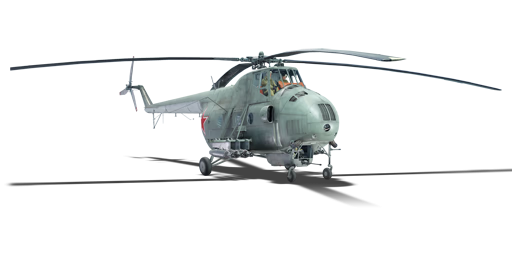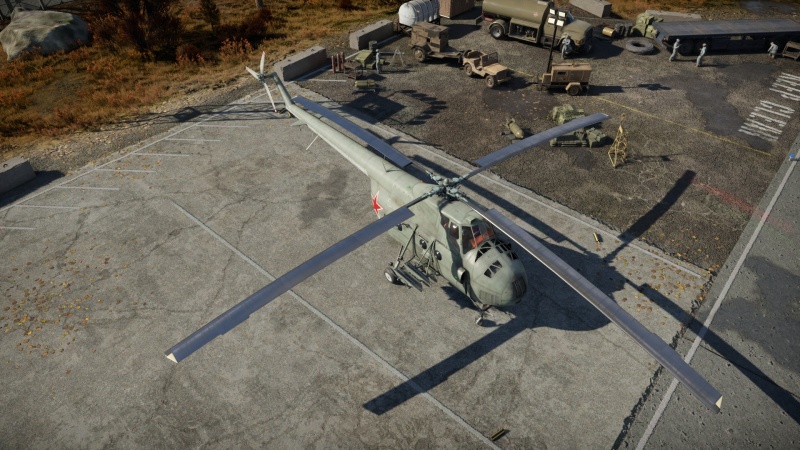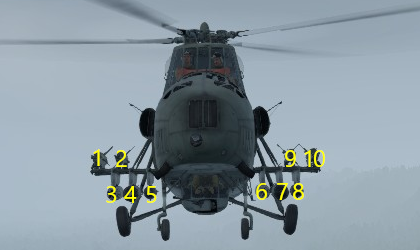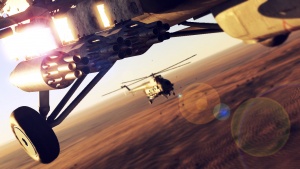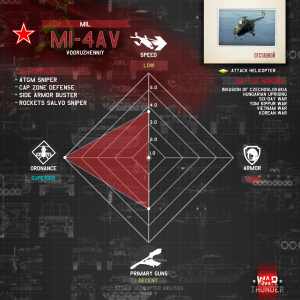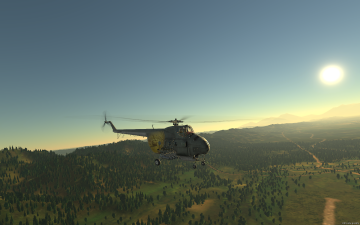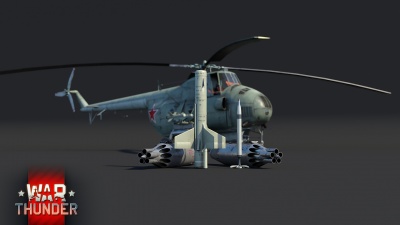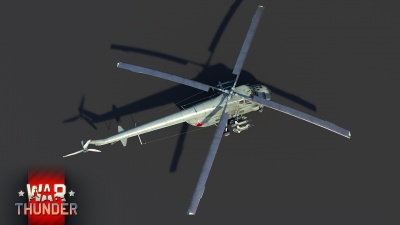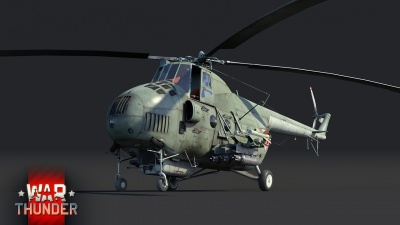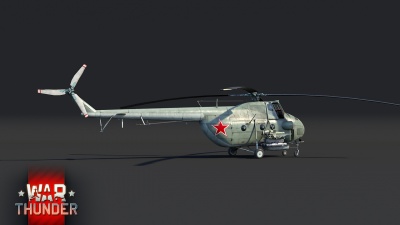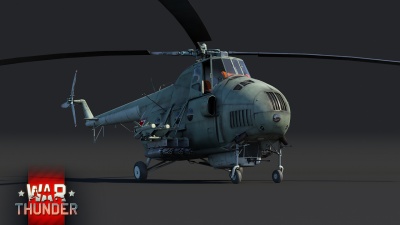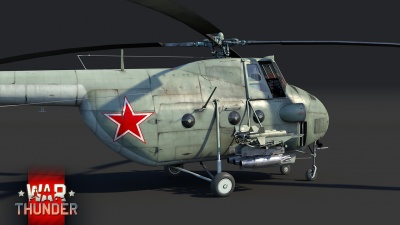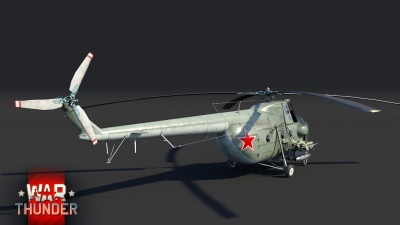Difference between revisions of "Mi-4AV"
(Entire page overhauled to meet modern game standards; removed mentions of helicopter PvP battles and updated various descriptions) |
(Entire page overhauled to meet modern game standards; removed mentions of helicopter PvP battles and updated various descriptions) |
(No difference)
| |
Latest revision as of 10:32, 4 July 2024
Contents
Description
The Mi-4 was designed as a response to the American H-19 Chickasaw and its effective deployment in the Korean war. Design and testing commenced in the early '50s, before being rushed into service in 1953. The Mi-4 would be adapted to many variants and see service with many countries around the world. One such variant was the Mi-4AV variant, where "AV" stands for "атаковать вооруженный" ("Atakovat Vooruzhennyy" — "Assault, Armed"). The Mi-4AV would serve a long and eventful life all around the world, from the orients of China to the deserts of Africa. Much like its American counterpart, after it was gradually phased out of military service, it was used in various domestic roles, including search and rescue, polar expeditioning, construction site cargo helicopter, firefighting, commercial flights, and much more.
The Mi-4AV (NATO reporting name: Hound), was introduced in Update 1.81 "The Valkyries". The Mi-4AV is the starter helicopter for the Soviet tech tree, and at first seems very underwhelming, but once familiarized can be one of the best starter helicopters in the game. The Mi-4AV has access to the Falanga ATGM with 4 km of range which in the right scenarios can be very deadly to enemy tanks. Pilots of the Mi-4 must be very careful of the aircraft's underpowered engine and abysmal flight performance: due to being a piston-powered helicopter, the engine is somewhat inadequate at full combat loads, and the helicopter will feel even more sluggish than it already is. This makes the Mi-4AV a very easy target for most radar-guided SPAA at range, due to its inability to dodge incoming fire very easily. However, the 4 Falangas it carries can also engage enemy SPAAs at ranges further than any other helicopter at its Battle Rating, and can cause devastating damage if left uninterrupted. All in all, the helicopter lacks the agility of other, lighter helicopters found in other trees but boasts a high number of guided anti-tank missiles that have the furthest range of any ATGM on a starter helicopter and can deliver lethal long range fires if given the opportunity.
General info
Flight performance
As a first generation transport helicopter, the Mi-4AV is very slow, it is rare for it to reach 200 km/h. Additionally, the Mi-4AV has a poor roll rate. When fully loaded, the performance deteriorates even more, making the helicopter an easy target. Pilots should keep this in mind when choosing the payload.
The newest pilots should not attempt to roll the helicopter more than 35°, since the Mi-4AV is underpowered and cannot handle such manoeuvres. The weight will force the helicopter down (worse when fully loaded) and the main rotor will be unable to sustain the helicopter in this awkward position, making recovery impossible. The risk of stalling is significant, and it is recommended to set the the collective pitch to around 80% for cruising, and 100% only when climbing is needed.
It should be noted that even in hover mode, the underpowered engine will start overheating, forcing you to reduce engine power and slowing down the machine even more. Even once fully upgraded, this remains a burden. This is particularly important on hot weather maps such as Sinai or Tunisia.
| Characteristics | Max Speed (km/h at 500 m) |
Max altitude (metres) | |
|---|---|---|---|
| AB | RB | ||
| Stock | 173 | 162 | 6000 |
| Upgraded | 206 | 190 | |
Survivability and armour
Unlike the later helicopters in the Soviet/Russian helicopter tree, the Mi-4AV is essentially a transport helicopter with weapons strapped to it, and it carries no armour plating whatsoever.
The Mi-4AV is also very vulnerable to engine damage because the engine is located in front of the pilot, in the nose of the helicopter. This is especially similar to the H-34 it was designed as a response to, and means that the engine will often be the first part hit by ground fire. Once the already underpowered engine is hit, this will deteriorate performance even more, potentially to the point where the helicopter may no longer be able to stay in the air. Pilot snipes are also frequent, and will send you back to the vehicle selection screen faster than the time it takes for your helicopter to hit the ground.
The airframe itself is relatively resilient to machine gun fire, although anything above autocannon fire will easily rip the helicopter to shreds. The fuel tanks are self-sealing, but this will be one of the least hit parts on the helicopter. You may occasionally survive a grazing kinetic round (AP, APDS, APFSDS) to the rear part of the helicopter, but it is also a possibility that they hit the front and cripple or kill you outright with a single shot, so it's always best to not tempt fate in this regard.
Modifications and economy
It is highly recommended to prioritize the 2P32M/K-4V modification (to increase the amount of missiles carried from 2 to 4) first and foremost, as it directly increases your combat capabilities in Ground Battles, your primary battlefield in the Mi-4AV. After this, performance modifications are recommended, as the helicopter is held back the most in its lacking engine power rather than its armament options. It is not particularly recommended to research bombs or NVDs as the Mi-4 can rarely get in close enough to drop bombs (or accurately bomb them due to its lack of CCIP as well as its docile airframe) and no longer sees Night Battles at its Battle Rating of 8.0 (Night Battles are now available only to players who opt in and have a vehicle of BR 10.0 or above in their lineups).
Armaments
What the Mi-4AV lacks in performance and durability, it makes up for in armament. Of the Rank V helicopters it is easily the most heavily armed, once fully upgraded, capable of carrying rockets, bombs, and anti-tank missiles. The most commonly used armament preset will be the 4 Falangas, as the other options generally synchronize poorly with the lumbering airframe of the Mi-4.
Offensive armament
The Mi-4AV is armed with:
- 1 x 12.7 mm TKB-481 machine gun, nose turret (200 rpg)
The Mi-4AV is armed with a single flexible TKB-481 machine gun. This gun has a limited arc of only +- 30° horizontally, -55° and 0° vertically. The gun possesses a decent amount of ammunition (200) and a high rate of fire (1,100 rounds per minute). This machine gun is mostly effective against soft vehicles and ground targets, such as artillery emplacements, armoured cars, trucks, and light vehicles. It lacks the penetration to damage anything heavier than some light tanks' roof armour.
Due to the limited arc and the relatively low calibre, air-to-air engagements relying on this machine gun can be difficult. It works best as a defensive armament against other light and poorly armoured helicopters such as the Franco–German Alouette (Family) and the American Hueys. Overall, it is best not to rely on this gun for self defense (i.e. don't be cocky and expect that you can win handily in a close range fight), but it is also important to remember it is still available as you may catch the odd propeller plane player off guard and pilot snipe them in return.
Suspended armament
The Mi-4AV can be outfitted with the following ordnance:
| 1 | 2 | 3 | 4 | 5 | 6 | 7 | 8 | 9 | 10 | ||
|---|---|---|---|---|---|---|---|---|---|---|---|
| 100 kg FAB-100sv bombs | 1 | 1 | 1 | 1 | 1 | 1 | |||||
| 250 kg FAB-250M-46 bombs | 1 | 1 | 1 | 1 | |||||||
| S-5K rockets | 16 | 16 | 16 | 16 | 16 | 16 | |||||
| 9M17M Falanga missiles | 1 | 1 | 1 | 1 | |||||||
| Maximum permissible weight imbalance: 500 kg | |||||||||||
| Default weapon presets | |
|---|---|
| |
The S-5 unguided rockets are available without research. They are not accurate and do not have a large explosive payload. Since it uses a shaped-charge warhead, a direct hit is required in order to damage most enclosed armoured vehicles, and aiming is complicated by the fact that the Mi-4AV does not have a ballistic computer. Even on direct hit, due to the nature of HEAT warheads, damage may be minimal, so firing off multiple rockets at a target to thoroughly cripple or kill it is near-essential. Open-topped vehicles, however, are generally easy pickings so long as you land your rockets near them as you may overpressure them with even a glancing hit.
The 9M17M Falanga should be considered the main weapon of the Mi-4AV. These missiles are semi-automatic (SACLOS), which means that the pilot does not need to manually fly the missile all the way to the target. It does, however, require that the pilot keep the sight crosshairs on the target in order to ensure a hit. This, in turn, means the helicopter must remain relatively stable, making it a vulnerable target. The Falanga has the longest range of all the anti-tank missiles available to starter helicopters (4 km vs. 3 km for the AS.11), which allows the Mi-4AV to attack while remaining out of reach for most contemporary SPAAs. It is also important to note that the Falanga has a minimum effective range of around 500–600 m, as do other helicopter missiles, due to them having to 'pull in' for a short distance before aligning with your crosshairs.
You have access to 2 Falangas when stock, as well as the aforementioned S-5 unguided rockets. When fully upgraded, you can equip 4 Falangas, which is the preferred ideal loadout due to the other ordinance either needing the player to get in close (bombs and rockets) and drastically increasing your chances of being shot down near-instantly. The Mi-4AV is also capable of carrying bombs up to 250 kg in weight, in two different sizes. Their use is quite situational because they require the helicopter to fly over the target, which is quite risky in a helicopter as slow, docile and fragile as the Mi-4AV. In Realistic and Simulator battles, a time delay (at least 1.5s or longer at moderate altitude) should be set so the Mi-4AV does not damage itself with its own bombs.
Usage in battles
Pilots should be acutely aware this helicopter is not made for dedicated CAS (Close air Support), mainly because of its limitations such as a low top speed, big size, very low maneuverability and lack of countermeasures countermeasures. Instead, consider using it as a semi-mobile long-range fire support vehicle, using your Falanga missiles to stay out of range of enemy anti-aircraft fire and helping your team from afar.
Pilots must be alert of their surroundings, as you do not want to attract any unwanted attention to your helicopter. If you are trying to rush a capture point or a spot on the map with rockets, flying low and behind terrain is key, as even one aware anti-aircraft or autocannon-equipped player can easily spell doom for your lumbering helicopter. If you are trying to support your team at range with ATGMs, check the minimap every now and then as well as the killfeed to look for any enemy aircraft and/or anti-aircraft fire directed towards you. However docile your helicopter is, dodging is still an option at long range so vigilance is key to staying alive for long.
In general, the Mi-4AV is best suited for longer range, while its close range capabilities are limited not by rocket carrying capacity but by the airframe's large size and lacking agility. Players should plan accordingly and either exploit map geometry to unleash your large supply of rockets on unsuspecting enemies or stay at long range and maximizing your own strengths. A tip for dodging SPAA fire at range is to tilt your helicopter sideways when guiding in a Falanga. As long as you don't tip over the helicopter (a genuine concern for the Mi-4 due to its docile handling), the missile crosshair will still remain on target even when you roll the helicopter, meaning you can mostly guide in your missile undisturbed while dodging direct enemy gunfire. It is recommended to sway left and right somewhat unpredictably, as this will throw off most players aiming directly at the reticule. You can change directions accordingly when you see the enemy player adjust their aim, which will be noticeable by the tracers deviating from previously fired shells in direction. You should also immediately retarget to the enemy anti-air vehicle firing at you unless absolutely necessary, as staying alive and delivering long range fires is better than securing one kill and then immediately exploding midair.
Enemies worth noting
Most anti-aircraft vehicles will pose a direct threat to your helicopter as will some supporting vehicles. It is recommended to stay vigilant and attack targets with a priority list of sorts mentally in your head at all times. Important enemies (Priority Targets) are marked in bold text.
- Gepard, Type 87, PGZ09: The Gepard and similar systems like it will be your primary threat. They are highly mobile, have fairly long detection and lock-on ranges, and fire shells with fairly high velocity, and as a result can be lethal should you not notice them. You can somewhat play around them by sticking to longer ranges (~3 kilometers from your targets) and swaying left and right in the roll axis to throw off their shells, as you guide in a Falanga into their turrets.
- Chieftain Marksman, ItPsV Leopard, ZA-35: The Marksman (or similar) anti-air systems available on these anti-aircraft guns are similar to or slightly inferior to the vehicles listed above; while they share cannons in the form of the 35 mm Oerlikon and are both mobile vehicles, the Marksman system has a shorter detection range (12 km compared to 20 km on the Gepard/PGZ09 and 40 on the Type 87) and has a critical flaw stemming from its design - the spread out guns. Compared to the Gepard and its contemporaries the Marksman family will generally spray out a far less accurate spread of bullets, which can sometimes be a benefit up close but can also be dangerous at range as stray bullets aimed slightly next to you may deviate towards your vehicle instead due to the nature of the spaced out guns. Treat them with the same respect as the vehicles above for the most part to ensure your survival.
- WZ305: The WZ305 can be the absolute worst vehicle to face in any helicopter, not just the {PAGENAME}. The WZ305's DKY-1 proximity fused belt turns what was once a mediocre anti-aircraft vehicle in the form of the ZSU-57-2 into one of the most lethal anti-aircraft guns of its tier, should the user be aware of any vehicles in flight. As helicopters generally maintain a somewhat consistent distance between the battlefield and themselves, and as the Mi-4 particularly is a very large and lumbering vehicle, the proximity shells will have a much easier time connecting with your vehicle than other early helicopters or aircraft. A tell-tale sign of a WZ305 being active is seeing tracers spaced out in groups of 4, or in general seeing an anti-aircraft gun with a slow fire rate. If you see a WZ305 firing at you, you have only one option: quickly break line-of-sight, and pray. The Mi-4 is very sluggish at changing heading and speed, so if the Z305's shots were anywhere near the mark you will almost certainly explode. However, if he misses his first burst, you may have just enough time to dive away and reposition yourself. Engage WZ305s with the highest level of priority and caution.
- M247: The Sergeant York is a formidable proximity-fused SPAAG, and is a fairly common sight if you are fully uptiered or playing a lineup above 8.0. In essence a better version of the VEAK 40 and WZ305, the M247 can make short work of you should you be within 2.5 or so kilometers from the battlefield with its proximity shells. Your lack of a RWR (Radar Warning Receiver) means that even if an enemy M247 is locking you, you would be oblivious to it, and as the M247's proximity shell belt has no tracers the element of surprise can often feel almost unfair. However, the M247's proxy shells can often be fickle and self-detonate early, so you may have some time before the proximity fuse works properly and detonates your vehicle without warning. It is recommended to quickly fire off a missile at it the moment you spot one on the battlefield to not risk it altogether.
- M3 Bradley, Begleitpanzer 57, 2S38 and SAM systems: A caviat to note here is that the Begleit and 2S38 are impossible to face in the Mi-4 unless you are running a 8.3 or 9.0 lineup with the Mi-4 respectively. However, they are good examples of vehicles in their respective classes, so a mention will be made. Most 8.3 or 8.7 IFVs such as the Bradley or the BMP-2 will not have proximity shells, a laser rangefinder (depends on vehicle) or IRST (Infra-Red Search and Track) to aid in their AA role, so unless you are within 1.5 or so kilometers and have enough velocity you can usually evade their autocannons and missiles. However, vehicles like the Begleitpanzer pack a laser rangefinder, thermals to aid with awareness as well as proximity shells and can absolutely decimate you with almost no warning. The 2S38 is even more extreme, with a shell that has much less explosive mass but is tracerless, and the vehicle also comes equipped with an IRST system which will give the vehicle the lead it needs to aim directly at you. Against these advanced systems, regardless of whether or not you have to be in a mixed battle to see them, you have very few options other than hoping you notice and fire your munitions first. Extra caution is required if you wish to use the Mi-4 at these higher Battle Ratings to any effect, and it is strongly encouraged that you bring a more advanced vehicle in its stead such as the Mi-24P to deal with these threats more equally.
SAM systems may also be sighted at 9.3 or above if you have your Mi-4 in a 8.3 or higher lineup. These SAMs mostly consist of Imp.Chaparral-fired AIM-9D missiles as well as Stinger, Mistral or Igla MANPADS and the odd Lvrbv 701-fired manual SAM, and if they lock on to you they will generally be a guaranteed kill on you. If you know such a system is up, it is best not to get too close, as most early MANPADS struggle to gain lock at 3 or so kilometers against helicopters. Against these systems there is not much you can do than hoping you get to them before they notice or get a lock on you, so extra vigilance is again required should the player wish to use the Mi-4 at these higher BRs.
Role in the team
Once a Soviet Mi-4 pilot chooses to spawn in, there are several points they need to prioritize to actively boost their team during the battle.
- Where on the map are the enemy forces?
- Where on the map do our forces need air support? (If our team is attempting to capture a zone, for example)
- Is one of our capture points in need of defense?
This will now let pilots ponder about how to engage, mainly between whether or not to focus on rushing in with rockets or providing long range fire support with the Falangas. The prudent tactic is usually to stay far away, but this may differ on different maps as some maps may not allow for long-range fires either due to poor weather conditions in the match or poor firing angles. It may be tempting to simply sit back and missile anyone who comes into view, as a sort of god smiting down his enemies, but always remember that supporting your team in need by going for campers at the back of the map or in hard-to-clear places or people on capture points is infinitely more valuable than just getting odd kills on people that would have died anyways to your teammates in under 20 seconds.
Also remember that;
- Despite the natural difficulties of the mode, Simulator mode is greatly rewarding due to the stealth element. This can situationally allow pilots to execute a more offensive close approach with rockets and/or bombs.
- The pilots should be in the habit of checking for enemy planes up before spawning. This will avoid imminent annihilation by enemy planes already in the air.
- A group of Mi-4s (or really any group of helicopters) is more like to survive than a single Mi-4. If you are in a squad or notice teammates who can communicate effectively, don't be afraid to ask them to try out a team strategy. It's generally more effective to attack in groups and in a coordinated way, and you might even end up finding a friend after the battle.
Pros and cons
Pros:
- Fairly hefty payload options
- Falanga missiles can outrange cannon-based SPAA
- Relatively durable airframe.
- Comes with half its ATGMs stock
Cons:
- Incredibly large; easy to spot from afar
- Woefully underpowered; has poor speed and agility across the board
- Missile tracking field-of-view is quite narrow.
- Critical components (cockpit, engine, motor, and oil cooler) are all located close together at the front of the vehicle
- No sight gyro-stabilization system for simulator modes.
- No ballistic computer.
- Most ordinance outside of the Falangas are ineffective
History
The Soviet Army Aviation owes its emergence mostly to the transport landing helicopter Mi-4. The Mi-4 paved the way for helicopter usage in the Soviet national armed forces.
The Korean War was the main impetus in which provided the need for a Mi-4 helicopter which started its official development in the early 1950s. At the time, the American military was widely using helicopters as a force multiplier which enabled troops to advance and reinforce areas much quicker than when travelling by vehicle or more to a pinpoint location without needing finding or building an airfield. Through the use of helicopters, rapid and large scale operations became a possibility that had yet to be exploited to its fullest. At this time, the Americans were using different types of helicopters to do various tasks, depending on what payload was needed. Light helicopters were used for duties such as taking wounded back to hospitals, means of communication and spotters for artillery units. More massive helicopters were utilised for delivering troops, vehicles, supplies and artillery directly to the battlefield. The Korean War demonstrated the increased need for a role which rotor vehicles could fulfil within the Armed Forces.
Once realising their folly of not developing helicopters for inclusion in the armed forces, Soviet leadership decided they needed to make up for lost time and get to work designing and building their helicopter force. In October 1951, the leading aviation designers of the Soviet Union were called to the Kremlin. As a result of the meeting, tasks for developing new rotor vehicles were given to the aviation designers. Here, the Mil Design Bureau specifically was assigned to the designing and creating a landing-transport helicopter which could carry up to 12 persons. Quick work was needed because experimental models were required to be ready for trials one year after receiving this assignment.
Mikhail Mil began to work on a solution; however, unbeknownst to many, he already had a head start on this project which he called the VD-12 or Vertolyot Desantniy (a landing helicopter) which was designed to hold 12 persons. The design of Mikhail Mil's had been around since the end of the 40s. However, it never went anywhere because nobody was willing to support the project at the time. The lack of support extended from the military through the highest leadership in the country because they did not understand the battlefield benefits this tool would provide their soldiers. It wasn't until the Soviets were spectators in the Korean War that they saw firsthand the effectiveness of helicopters on the battlefield.
Initially the VD-12 was designed to receive a 1,000 HP engine; however, when the helicopter was ready to begin construction and to receive it, the engine was determined not to be ready for the deadline trials. Mil was then required to redesign the VD-12 to accept a more powerful and heavy engine, the Ash-82 developed by Arkadiy Shevetsov which was a couple of generations newer than the Ash-73TK utilised on the Tu-4 bomber. This piston engine had proven itself an excellent engine when employed on various aeroplanes. To accept this new engine, the helicopter needed to be enlarged to adequately encompass it. Yakovlev DB had intended on providing the rotor, main rotor head, wobble plate, reduction gear and engine for the project, however that was for the smaller VD-12 and all that had to be scrapped for the newer and larger helicopter. Igor Sikorsky developed the S-55 (H-19) which was very similar in size and layout, and Mil decided to model the more modern and larger helicopter off of the aspects of the S-55 which applied to his larger helicopter. The Radial engine was placed in the front nose with the drive shaft passing through the cockpit and turning the rotor, which left the lower section of the helicopter to be a large cargo cabin. Again the cabin needed to be able to hold 12 troops or various military equipment which weighed up to 1,600 kg.
With this plan in action, designers were working almost around the clock to complete the schematics. Within four months of the project starting, the prototype was rolled out of the hanger and prepped for flight. With the radial engine firing, the rotor began to spin, however during acceleration of the motor; the blades started to bend severely, threatening to break apart and destroy the helicopter. The rotor was powered down, and the minds went to work attempting to figure out what the issue was. Mil settled on the problem being the rotors fluttering, which for aircraft surfaces bending or flexion which causes material fatigue and the parts disintegrate thus destroying the entire project. To validate this theory, special weights were built in one night and then installed on the blades. A repeat of the experiment was conducted, and the rotor behaved in a manner it needed to work correctly. Further testing created a blade which was constructed to eliminate any flutter.
Seven months after receiving their assignment to develop and build a helicopter, the first helicopter trials were ready to begin. While the first test had the helicopter tethered to the ground to prevent any mishaps, on the 3rd of June, Vsevolod Vinnitskiy made the first free flight in the new helicopter. At this point, the VD-12 was the most significant and most massive lifting helicopter in the World. With the completion of the state's trials, the VD-12 began mass production, and its name was changed to Mi-4 and was introduced into service the next year.
In many ways the Mi-4 surpassed the US helicopter H-19's capabilities as the rear of the Mi-4 could open up and through the use of a ramp, men, vehicles and artillery could quickly be loaded and unloaded. Also installed under the nose of the helicopter was a gunner position with a 12.7 mm machine gun. The Soviet military found many uses for the new helicopter beyond just transporting people and equipment, and as more equipment was outfitted, the helicopter also took on roles such as ground attack and submarine hunter. More than 3,000 Mi-4 helicopters were produced during its years in service and proved to be an essential force multiplier on the battlefield for the Soviet Armed Forces.
Media
- Skins
- Images
- Videos
See also
- Aircraft of comparable role, configuration and era
- H-34 - Sikorsky Choctaw
- H-34 (France) - French variant of the Choctaw
External links
| Mil Moscow Helicopter Plant | |
|---|---|
| Attack | Mi-4AV |
| Mi-8AMTSh · Mi-8TV | |
| Mi-24A · Mi-24P · Mi-24V | |
| Mi-28N · Mi-28NM | |
| Mi-35M | |
| Export | ◊Mi-8TB |
| ▂Mi-24D · ◔Mi-24D · ◔Mi-24V · ◔Mi-24P · ◊Mi-24P · ◄Mi-24P HFS 80 | |
| Mi-28A | |
| USSR helicopters | |
|---|---|
| Attack | |
| Hound | Mi-4AV |
| Hip | Mi-8AMTSh · Mi-8TV |
| Hind | Mi-24A · ▂Mi-24D · Mi-24P · Mi-24V · Mi-35M |
| Havoc | Mi-28N · Mi-28NM |
| Helix | Ka-29 |
| Hokum | Ka-50 · Ka-52 |


